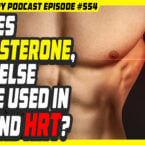Sign up to Get FREE Steroids, SARMS, Peptides eBooks
[sc:masthead-std]
[sc:salutation-std]
The subject of how much cardio to do on a bulking cycle has been debated all over the Internet. Too much cardio when you're bulking will cause you to sacrifice muscle gains. Some really old-school juicers recommend zero cardio when bulking! But what about your heart? Are you really going to cut cardio completely?
What I have found provides the best results if when juicers are on a bulking cycle is to incorporate two 30-minute sessions of cardio into their bulking cycle twice a week, if your bodyfat is below 12%, and possibly, but not necessarily, adding a third session if your BF is 12% and above.And when you are doing your cardio sessions, you also need to keep your heart rate in the moderate, Fat Burning zone and avoid getting your heart-rate up into the Cardio or Peak zones. This means no intervals or high-intensity style training when bulking.
But, if you're like most of the EF readers, I bet you are not a fan of moderation! And so, I'll bet my 20+ years in the industry, that many, if not most of you, think you are restricting your cardio to the moderate Fat Burning zone when you're on a bulking cycle, when in fact, your heart-rate is well into the Cardio or Peak zones. Likewise, on a cutting cycle, where it makes sense to incorporate intervals and high-intensity cardio in order to really elevate your heart-rate, I bet there are some of you not hitting the peak zone often enough while you are accidentally spending too much time with your heart-rate in the Fat Burn zone. If this is you, next time you cut, you would really benefit by shortening the duration of your cardio workout, while upping the intensity and getting your heart-rate up into the Peak zone more times.
The problem with everything I have just written is that while it all sounds good, not until very recently has it been easy to track your heart-rate to be sure which training zone you are really in. Not until very recently, with the invention of small, wrist-worn heart rate monitors like the Fitbit Charge HR, has tracking your heart rate to optimize it for your bulking or cutting cycle been practical. Unless you strapped a big contraption to your chest and wore it around all the time, accurately monitoring your heart-rate and thereby knowing what training zone you were really in, was all just guesswork.
The Fitbit Charge HR changes all that. It is a small $150 wristband that you can wear to monitor your heart-rate 24/7.
Here's what one looks like:
For bodybuilders, the best thing about the Fitbit Charge HR is the heart-rate monitoring technology. It enables you to “manage” your heart-rate within three zones to get the optimal results when you are bulking or cutting.
The zones are Fat Burn, Cardio, and Peak. The heart-rate icon on the Fitbit Charge HR lets you know which of the three heart-rate zones you’re in. Wearing the Fitbit Charge HR, you reach the different training heart-rate zones based on a percentage of your estimated maximum heart rate. Fitbit calculates your max heart rate with the common formula of 220 minus your age – but you can adjust this formula to suit your needs.
Low- to medium-intensity training is classified as the Fat Burn zone, measured at 50-69 percent of your maximum heart rate. In the Fat Burn zone, a higher percentage of calories are burned from fat, but the total calorie burn rate is lower. On a bulking cycle, targeting this zone when you train will maximize the muscle mass you build while still protecting your heart and keeping fat off.
The Cardio zone is 70-84 percent of your max heart rate. Medium to high-intensity exercise will put you in this zone.
Most interesting to me is the Peak heart-rate zone. This is the high-intensity burst exercise zone for short intense intervals – where your goal is to get your heart rate to over 85% of your max heart rate for brief intervals.
I’ve always been a big proponent of high-intensity, interval training (HIIT) because of the beneficial effect it has on your metabolism when you’re resting. Think of doing wind sprints. But, when I interval train, until now, all I would do is get my cardio workout going as fast as possible for 60 seconds, then I back off for the next 60 seconds, alternating back-and-forth like this for 20 minutes or so. The problem is that my historical way of interval training is not very scientific. Am I really getting my heart rate up enough? Am I really letting it slow down enough? Until now, it was all just guessing. With the Fitbit Charge HR, you can train and make sure you actually hit the Peak heart-rate zone before you back down to the Fat Burn zone.
Unlike other heart-rate monitors, you don’t need to strap the Fitbit Charge HR to your chest. And, since it is worn all the time like a watch (it also tell's time), you’ll get a more complete picture of your heart rate as it is worn all day and night. Your heart rate is monitored using safe LED lights on the underside of the wristband to detect blood volume and capillary-size changes under pressure. When your heart beats, your capillaries expand and contract based on blood volume changes.

The Fitbit Charge HR has a watchband style buckle that is much more secure than the clasp on the Fitbit Flex and basic Fitbit Charge - neither of which track heart-rate. And one final major benefit to bodybuilders is the sleep tracking feature. With past Fitbit models, you had to activate sleep tracking when you went to bed, but with the Fitbit Charge HR, sleep is detected automatically. There’s even a vibrating alarm that will wake you up gently in the morning, but not your wife or girlfriend!
Whether your looking to run a cutting cycle or bulking cycle, try the FitBit today and post your experience and review on the EliteFitness Forums.
[sc:signoff-std ]





